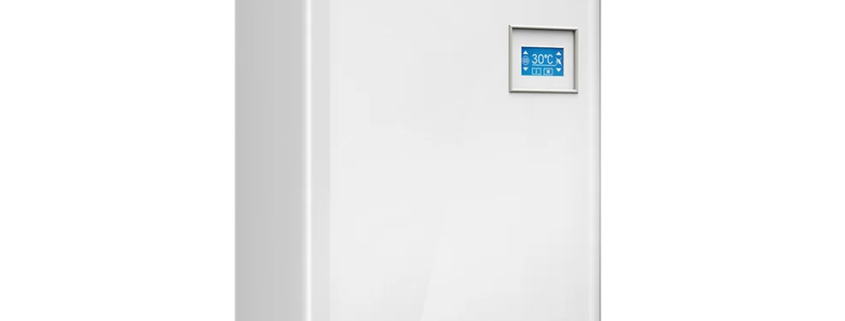 Flexiheat UK
Flexiheat UKElectric Central Heating Boilers – 0.5kW to 45kW
Electric central heating boilers – Over 2 million homes in the United Kingdom are at present without a mains gas network supply, also many older properties have flue restrictions or are listed buildings that prevent the use of a gas or oil boiler on site even if they have a gas supply.
In these situations, an electric boiler can be the perfect solution to your central heating needs. Some of the benefits of an electric wet central heating system boiler is that they fairly small and compact, so can often fit in a kitchen cupboard or under the stairs etc. The other great benefit is there’s no flue pipe required, unlike an oil or gas boiler which require a flue system to evacuate the products of combustion i.e., the flue gases. Thus, there is no risk at all of CO2 poisoning from a faulty flue system or the boiler when you use an electric boiler system.
This requirement for no flue pipe, allows you to install your electric heating boiler in the appropriate location, to suit your requirements, which is often not the case for a flued traditional gas and oil boilers.
Gas boilers obviously require a gas supply, be it a mains gas supply to feed the gas boiler, or alternatively gas boilers can also be powered by lpg gas, normally when not on the mains gas supply, which either require a bulk storage tank or cylinders – which can be unsightly- making traditional gas boilers undesirable. Electric boilers tend to be a great solution in these circumstances and can reduce your carbon footprint / carbon emissions as well as they are not burning a fossil fuel.
This electric boiler range are for a wet central heating system in a domestic property type, if you require an electric boiler to be controlled by a building management system such as ModBus , or 0 -10 volt control that commercial building often use, then you need to use our commercial electric wall hung boilers which have an upgraded control panel, which can do the forementioned control regimes.
These boilers are only for sealed heating systems and are not suitable for an open vent heating system, the minimum operating pressure of the heating system needs to be 1 Bar.
Central heating with sustainable energy
As a result of the recently passed legislation regarding boilers, there will be no new gas boilers installed in newly built homes after the year 2025 to meet climate change targets. Therefore, any new house constructed after the year 2025 will be equipped with an alternative kind of heating, such as a electric boilers, for instance. The days of the gas boiler are numbered as they say.
Energy-efficient hot water system
A gas boiler, even an a gas condensing boiler has a nett thermal efficiency of 92-95%, when the gas boiler heating systems circuit temperature is be below the dew point of flue gases (55°C), ideally below 52°C.
Electric boilers are 100% efficient no matter what your central heating systems temperatures are.
Electric Boiler – What are they ?
The most commonly installed boilers either use gas or oil to heat the water, whereby electric boilers work by heating the water via an electric element (called an immersion heater) or multiple elements / heaters for the central heating – that the only difference to an oil boiler or gas boilers.
They are normally powered by the mains electricity supply. You can also generate your own electric energy via solar PV panels for example, and help reduce your carbon footprint even further as well your energy bills.
Should you supply the boiler with electric generated via renewable energy sources such as wind turbines, tidal or solar PV panels etc, then you can have a zero carbon footprint, as these forms of energy don’t produce carbon emissions at all and reduce your energy bills. All you need is an electricity supply.
They are a popular choice for flats and homes where gas is not an option and oil is either impractical or too expensive.
Gas boiler
Unlike gas boilers on a mains gas supply or LPG gas supply, electric boilers don’t release waste gases as no fossil fuels are being burnt when operating – thus have a lower carbon footprint.
Just like a gas or oil boiler, our electric hot water boiler should be fitted by a professional heating engineer / qualified heating engineer often in conjunction with an electrician to wire the electricity supply to the boiler.
Advantages of electricity powered electric boilers
Economical
Can be integrated with PV panels to yield further energy savings, or use a cheap energy supplier / energy prices such as economy 7 tariffs, as the units can switch to these supplies automatically, and reduce running costs from these cheaper energy prices
Cheap to buy as electric heating boilers have no gas valves, fans or burners which keeps the cost down as opposed to the average gas boiler. Whilst an oil boiler requires an oil tank to be fitted. Also, an oil tank can also be unsightly and aesthetically pleasing.
No yearly servicing is required
No yearly Gas Safe Certificate in relation to rented properties – that gas boilers heating systems require.
Running costs can be reduced by using a external temperature sensor so the boiler can optimize and compensate to external weather conditions – further reducing running costs.
Cheaper to install
Installing an electricity powered boiler is simpler than a gas boiler or an oil boiler (no oil tank required for example) and so is quicker and cheaper, also as there are no waste gases an electric heating boiler doesn’t need a flue/ chimney system so the installation of the boiler will cost you less.
You do not require an external wall for installing electric boilers
Any competent heating engineer can fit an electric boiler and boiler installation costs are lower as compared to gas boilers. Most heating engineers work or partner with an electrician and work with each other to deliver complete boiler installations
High efficiency
As electric boilers don’t need to burn fossil fuels to produce heat, they don’t lose energy through waste gases or flues. In many cases this results in efficiency rates of 100% compared to 80 – 90% for most gas boilers and oil boilers.
Quiet
Electric boilers are almost completely silent as there are no moving electrical components or elements within the boiler
Light and compact
They lack waste gases and thus any flue / chimney means the unit is much more compact and lighter, ensuring you have more flexibility about where in the property you have it installed. This makes them much more versatile in terms of where they can be placed in the property. Most electric boilers are small in dimensions.
Easier to maintain
No annual landlord gas safety certificate is required
Unlike gas and oil boilers, electric boilers don’t need annual servicing to keep them functioning thus reducing running costs.
Safety
No carbon monoxide threat to the people within the property
No CO detectors accessories are required
Totally safe when the boilers are protected by RCD & MCB
No condensate pipes to freeze up
Can be used with radiators and / or underfloor heating systems
Electric flow boiler
When compared to a storage heater system/electric storage heaters that use a heating element to charge heating brick’s up overnight, a wet system is more responsive to the days heating requirements. By heating bricks overnight, you are always trying to second guess tomorrow weather, and often end up with wasted energy, the same applies to a storage electric boiler with a combined primary storage unit, often a lot of energy efficiency is wasted, for the heating and hot water in this case.
A wet central heating system can react a lot quicker, to variable heating demands, when using an electric flow boiler.
Electric combi boiler
Electric combi boilers supply both heating and hot water in one combined unit, providing central heating and domestic hot water.
Electric combi boilers tend to be limited as to the amount of Domestic Hot Water (DHW) they can produce instantly as opposed to a gas boiler -therefor we always recommend using an indirect hot water calorifier for the domestic hot water, especially if the property has a bath fitted as well as a shower .
We do a electric combi boiler range, but as a general rule after 15kW output a combi boiler will work and produce hot water on demand but at this output and above (we go all the way up to 40kw boilers electric combi) they require a 3 phase electric supply.
Below 15kW , which can be run off a 1 phase supply , then basically an electric combi boiler doesn’t produce enough warm water to satisfy most DHW demands, but we do have a solution, please see our dedicated electric combi boiler webpage for more info on how we overcome this.
Electric Boilers for Central Heating
Our range of lower emissions electric boilers for heating are fully adjustable in heat output to suit your requirements. For example, we often get asked for a 24kw electric boiler, this heat output is covered by our FHEL30 system boilers electric – which has a max central heating power output of 30kW. This boiler heats in steps of 5kw outputs, which you can easily set the maximum central heating output on the boiler, to 5kW,10kW,15kW,20kW,25kW or the maximum 30kW. Thus, for a 24kW electric boiler output, you can set the boiler to 25kw, which is just slightly over in heat output, by 1 kW. The additional potential power of the 30kW electric boiler is always a handy feature, should you wish add additional heat emitters to your heating system in the future.
Here is a list of the appropriate electric heating boilers to use for a particular heat requirement –
- 9kW electric boiler – this is our most popular size electric boiler – it has its own dedicated webpage here – 9kw electric boiler – close heat load match with 1kW heating element / power steps – this is the best 9 kW electric boiler on the market.
- 10 kw electric heating boiler – We would recommend our “FHEL15” unit, as it has 6 steps or power levels with 2.5kw heating element increments, so can be set to make a 10kW electric boiler. Our other option is our FHEL14, which due to its low minimum performance (1kW) and the modulation option, with heating steps of 1.5kW, can produce 10.5kW of heat output. This electric boiler is the ultimate in heat load matching and recommended for low-energy and passive houses (low minimum power)
- 12 kw electric boiler – for a 12kW output – you can use our FHEL15, which will give you 12.5 kW of output, or our FHEL14 model which will give you 12 kW of heat output
- 14.4 kw electric boiler – for a 14.4 kW electric boiler – you can use FHEL15, which gives you 15kW of output. We have a dedicated webpage here on this popular boiler – 15kw electric boiler
All boilers above 15kW are 3 phase boilers
- 18 kw electric boiler – for an 18kW electric boiler output – you can use our FHEL23 model, which can give you either 17.5 kW or 20 kW of heat output.
- 20 kw electric boiler – for a 20kW electric boiler output – you can use our FHEL23 model, which will match the exact output of 20 kW.
- 24kw electric boiler – for a 24kW electric boiler – you can use our FHEL30, which will give you 25kW of heat output.
- 30 kw electric boiler – for a 30kW electric boiler, use our FHEL30, which matches the output exactly.
- 36 kw electric boiler – for a 36kW electric boiler use our FHEL45, this will give an output of 35kW or 40kW.
The smaller electric system boiler range, i.e., from 0.5 kW to 15 kW outputs the electric boilers are available in 240-volt, Single Phase, after 15 kW the units require a three phase power supply. They are often fitted in new build homes and flats as they are cheaper to install and maintain. Also, with no gas emissions, they are seen by many as a more environmentally friendly choice, as the electric power supplied can be from renewable sources such as wind, solar or tidal/wave electric production.
What size electric heating boiler do I require?
The first part of selecting the correct electric heating boiler is the heating load (kW requirement). You can do this in a couple of different ways –
Here’s a quick chart for central heating system sizing – for properties built after 1990
| Power Output of Boiler | Heating area with H=2.7 Mtrs & U Value =0.3 | |
| 4.5 kW | ~ 55 m2 | |
| 7.5 kW | ~ 85 m2 | |
| 9 kW | ~ 110 m2 | |
| 13.5 kW | ~ 165 m2 | |
| 15 kW | ~ 180 m2 | |
| 22.5 kW | ~ 278 m2 | |
| 24 kW | ~ 300 m2 | |
We have a full dedicated webpage on how to size an electric boiler here – What size electric boiler do i need ?
Electric system boilers – Things you need to consider and know
Firstly if you don’t know what an system boiler is – we have more detail on this dedicated webpage – Electric system boiler
The biggest and most important issue with electric boilers is not the boilers themselves, it is the power that they require to operate
A typical house will have a single-phase supply whilst a larger house, blocks of flats or commercial building will need or have a three-phase supply.
A UK home typically has a single phase / 240 Volt supply with 100 Amps, this means that all the home electrical appliances, whilst being used simultaneously should not draw over 100 Amps, otherwise the fuse can blow.
So, for example our 15kW electric system boiler at maximum output can consume 66 Amps – should for example a kettle, tumble dryer or an iron (which each can consume 13 Amps each) or 39 Amps in total be used at the same time, then you could exceed your total of 100 Amps and blow your consumer board fuse. Our system monitors the Amps being used for the electrical system – 60 times a second – and will temporarily reduce the boiler output – until the Amps to power the boiler are available again – all automatically – thus you will never exceed your available Amps – and never blow your fuse – guaranteed!
For more information on this accessories system, please see this dedicated web page – maximum current watcher
Electric Central Heating Boilers – Features & Benefits
All of our “FHEL” range of Electric Central Heating boilers benefit from –
- Option to produce domestic hot water via an external indirect cylinder / calorifier and 3-way valve accessories.
- An inbuilt energy saving pump ErP rating label compliant heating electric circulation pump
- Pump Anti-Block Function – Regular spinning of the pump (once every 24 hours) prevents potential clogging of the pump during extended boiler down time
- Very quiet operation due to selected switching relays
- Anti-Freeze protection system – ensuring that these electric boilers are protected against freezing and any potential damage.
- Option to monitor the maximum current drawn to prevent overloading of the consumer board in the building/property – this system reduces the input power to the electric boiler automatically – ensuring that your main fuse does not blow.
- Soft start function – This ensures gradual heat-up of the heating system which is therefore protected against an abrupt temperature rise in the central heating system, that can cause noise due to the expansion of pipes.
- Balanced service load of heating elements – The microprocessor controller measures the operational time of individual heating elements and actuates them in a manner which ensures a thermally balanced loading of the boiler and an even service load of the heating elements, which extends their operational life.
- Each boiler is tested – on water circuit tightness and the function of the regulating and safety components is set and tested as well, before it leaves the factory, and comes with a warranty cover.
The Standard Range of Electric Heating Boilers
The Standard Series of Heating Boilers –
The standard range is available in 7.5kW,15kW,22.5kW,30kW,37.5kW and a 45kW Output models. This electric boiler range goes from 2.5kW to 45kW of output, with the following benefits –
- Fluent regulation (boiler output) in low power steps of 2.5 kW for the boilers up to 30kW, and 5 kW for 30 kW to 45kW models
- Option to connect the boilers to an Opentherm+ thermostat or controller e.g., a nest controller etc (control your boiler on the go, from your phone)
- Compensated weather control option for boiler – i.e., control / output according to the outdoor temperature (a great energy saving feature)
- Outputs of up to 15kW, when using a 240 Volt / 1 Phase electrical supply – and up to 45kW when using a 400 Volt / 3 Phase electrical supply
- All of these electric boilers up to 23kW Output have an inbuilt 7 litre expansion vessel inbuilt (i.e., a system boiler), after this size the boilers must use an externally mounted expansion tank dependant on system volume and temperature stars max central value.
- Option to monitor the maximum current drawn to prevent overloading of the consumer board in the property – this system reduces the input power to the electric boiler automatically – ensuring that your main fuse does not blow.
Please note the following for the for the rated current of these electric boilers – The smaller electric heating boilers up to 15kW, can be wired from either a three phase / 400-volt supply or a single phase 240-volt supply – thus on these units you will see two sets of figures for the maximum rated current – the first number “3 x 12” for information on the FHEL8 Model, is the 3 phase Amps – therefore 3 phases, with 12 Amps on each phase. The second figure in the brackets (1×36) is the single-phase Amps information – therefore Single phase / 240 Volt pulling 36 Amps maximum for the FHEL8 Boiler. The same applies for the main circuit breaker figures for the boilers – the first figure is if you use 3 phase supply to connect the boiler up, and the bracketed figure i.e. (the number within here) is the size require if you use a single phase supply to wire the boiler up.
Standard Series – Electric Boilers – Technical Data
Electric Boilers- with touch display
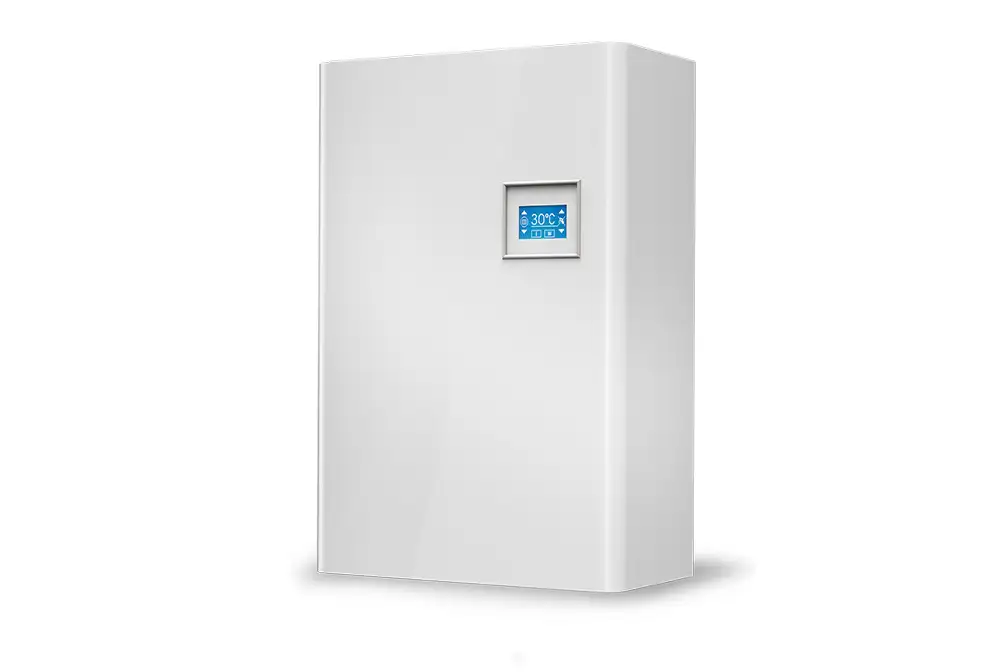
Electric system boilers from Flexiheat UK, with touch display – the best electric boiler on the UK market, with the best heat load matching of any electric central heating boiler on the market. Available in outputs from 0.5 kW to 13.5 kW
The next option in the Flexiheat UK electric central heating boiler product portfolio is the touch screen range. This range of electric heating boilers, are available in three sizes – a 4.5 kW output electric boiler, designated the FHEL5, a 9kW output electric boiler , designated the FHEL9 , and the largest unit being the 13.5kW output electric boiler, which is designated the FHEL14.All of this range are suitable for a single phase – 240 volt supply or can also be wired from a three phase -400 Volt supply. This range of electric boilers has all the features of the standard series , with a few notable enhancements, these being –
- Simple and intuitive control of the boiler ,due to the well arranged touch display
- Fluent regulation in low power output steps by 500 Watts (0.5kW) for the FHEL5 model, by 1,000 Watts (1 kW )for the FHEL9 model ,and 1,500 Watts (1.5kW) for the FHEL14 model. These lower power outputs ensure that the heating load requirement is appropriately matched. and brings even greater heating efficiency to the wet central heating electric boiler system.
- Minimum output of these boilers is 500 Watts (0.5kW) for the FHEL5, 1000 Watts (1 kW ) for the FHEL9,and 1,500 Watts (1.5kW) for the FHEL14 models , which all helps to increase the efficiency of the electric heating boiler system.
- Due to the low minimum performance and the modulation option, these boilers are recommended for low energy houses and passive houses ( ultra low energy buildings )
- The modular digital control assures optimal operation of the boiler in a way that optimizes electric energy consumption with the rated thermal output of the electric boiler.
Please note the following for the rated current of these electric boilers – These smaller direct electric boilers up to 13.5 kW in output ,can be wired from either a three phase / 400 volt supply or a single phase 240 volt supply – thus on these units you will see two sets of figures for the maximum rated current – the first number “8” for example on the FHEL5 Model , is the 3 phase Amps – therefore 3 phases , with 8 Amps on each phase. The second figure in the brackets (21) is the single-phase Amps – therefore Single phase / 240 Volt pulling 24 Amps maximum for the FHEL5 Boiler. The same applies for the main circuit breaker figures for the boilers – the first figure is if you use 3 phase supply to connect the boiler up , and the bracketed figure i.e. (the number within here ) is the size require if you use a single phase supply to wire the boiler up.
Touch Screen Series – Central Heating Boilers – Technical Data
Download the Flexiheat Brochure For Electric Boilers “FHEL” Range
Download the Flexiheat Electric Central Heating Boilers – Installation & User Manual – FHEL Boilers
Electric boilers for hot water and central heating
By using the heating electric boiler in conjunction with an indirect domestic hot water cylinder, then you can supply plentiful amounts of Domestic Hot Water for your bathing, be it showering or filling a bath and washing up requirements.
This hot water system ensures that the electric boiler does both your heating system and domestic hot water – the wet central electric heating system, be it radiators, under floor or a mixture of both and the domestic hot water via indirect cylinders. In these circumstances the electric boilers are referred to as a system boiler.
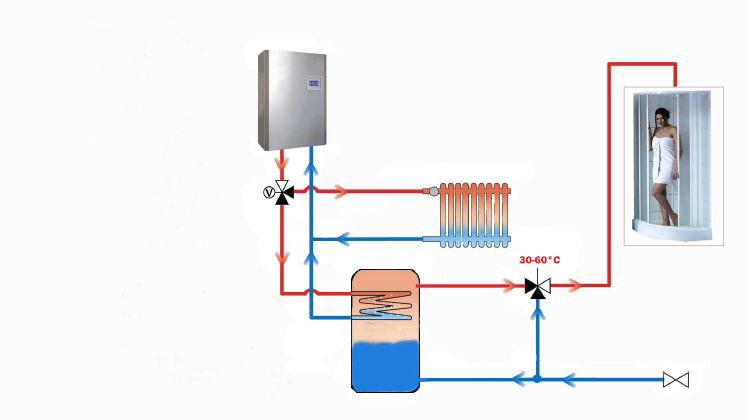
A diagram showing how an electric heating boiler is connected to a Domestic Hot Water Storage Cylinder or Hot Water Tank
An electricity powered boiler can be used as either a “back up” or a “top up” heater for a solar heating system.
Using your appropriate size electric boiler in conjunction with solar water heating to reduce your reliance on bought in electricity or reduce your electricity costs.
Electric boilers for sale UK & Ireland
Should you require anymore assistance or information on the best electric boiler / electric central heating boilers on the UK and Irish markets, please contact our sales team on 01202 822221 or click here for our email contact form. All of sales are supplied with a vat invoice.

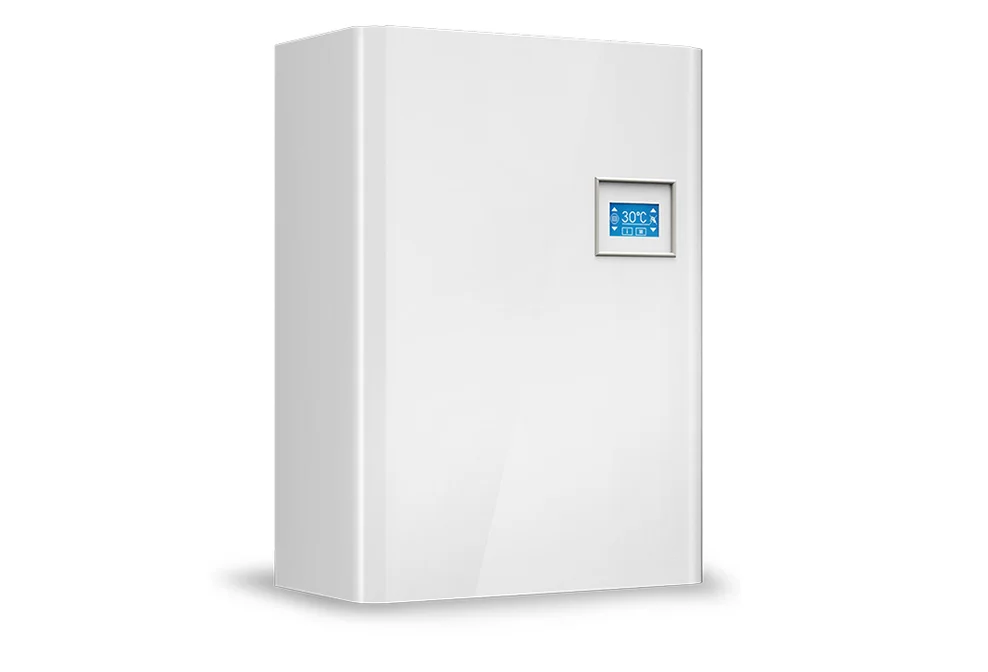
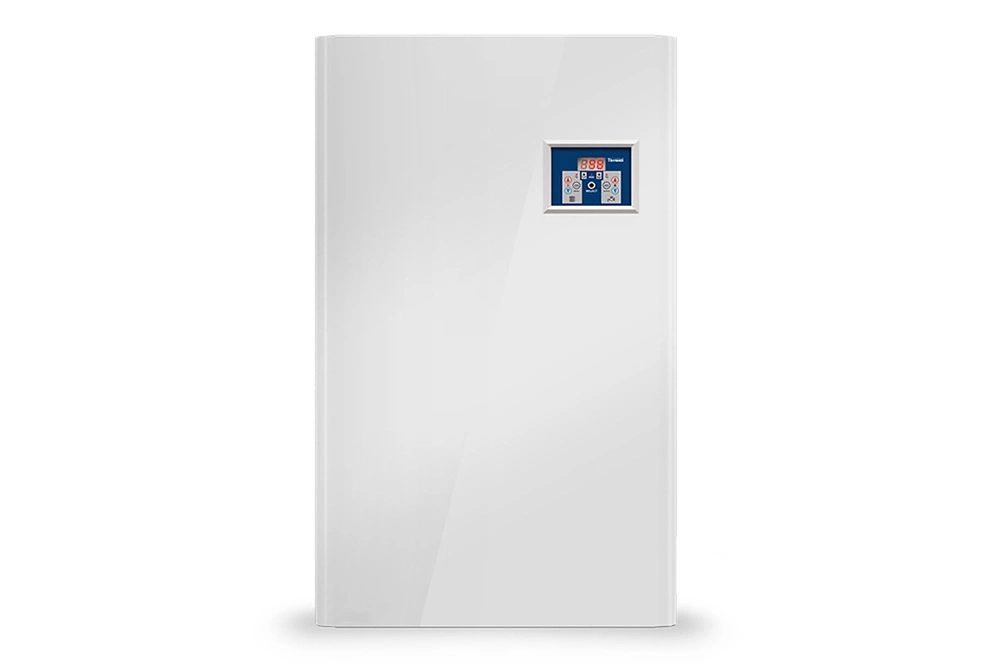
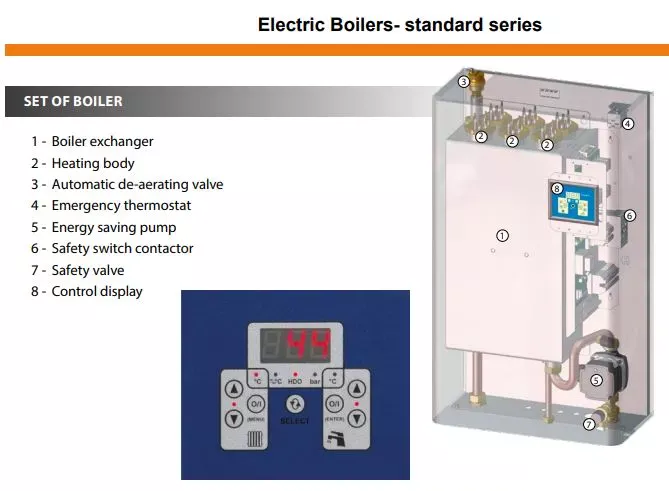
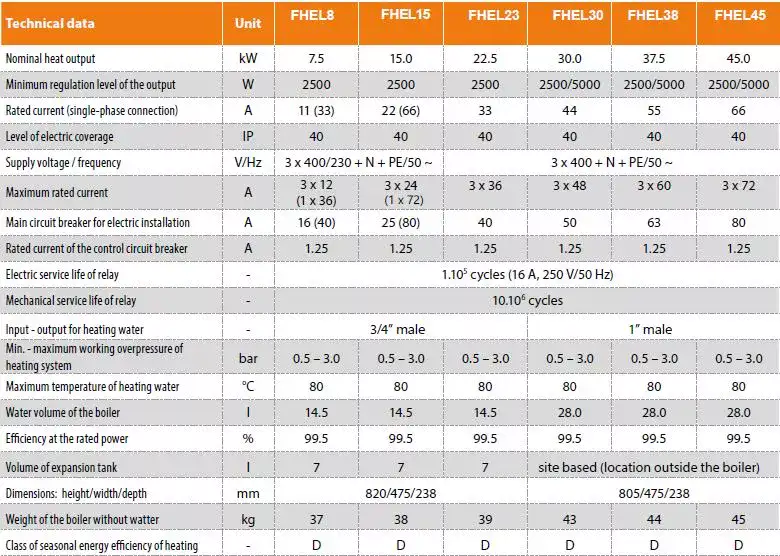
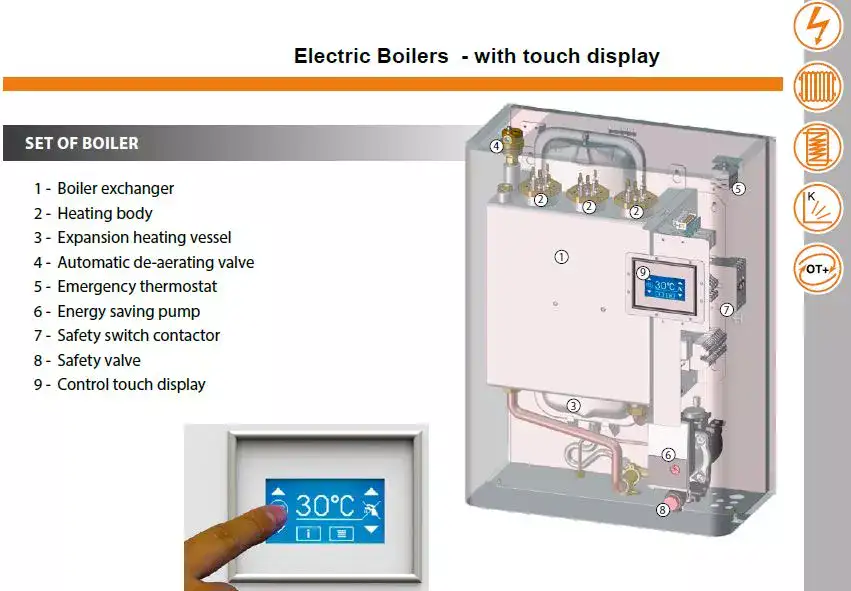
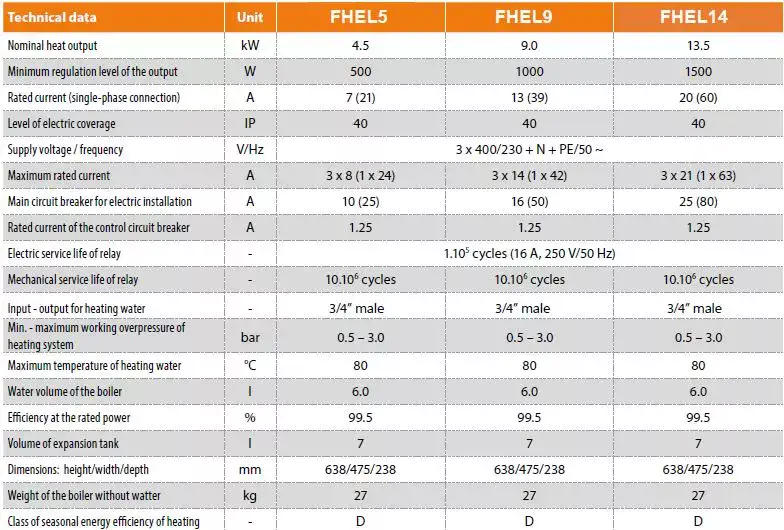
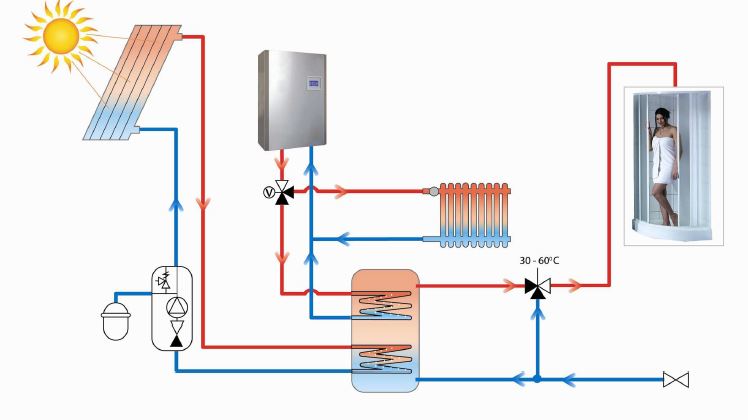
 Flexiheat UK
Flexiheat UK